Predictive modeling, which examines historical data to uncover trends and forecast future outcomes, is becoming essential for businesses looking to make informed decisions.
The global predictive analytics market was valued at approximately $5.29 billion in the past and is projected to expand to $41.52 billion by 2028, highlighting its growing importance.
As we approach 2025, the role of predictive modeling is set to expand, driven by advancements in AI & machine learning solutions. These technologies will improve the accuracy and timeliness of data-driven decisions.
This article will uncover the basics of predictive modeling in 2025, its benefits, emerging trends, and best practices for businesses aiming to use this powerful tool in the coming years.
So let’s get started with understanding predictive modeling.
Predictive Modeling: Key Steps and How It Works?
Predictive modeling is a statistical and machine learning approach used to create mathematical models that forecast future outcomes based on historical data.
These models identify patterns and relationships within datasets to make data-driven predictions, enabling businesses and organizations to anticipate trends, risks, and opportunities.
Predictive modeling involves several key methodologies, including:
- Regression Analysis: A statistical method used to predict a dependent variable using one or more independent variables. It is commonly applied in sales forecasting, credit scoring, and risk analysis.
- Time-Series Modeling: Analyzes sequential data points over time to identify trends, seasonality, and patterns. Businesses apply this for inventory management, demand forecasting, and financial analysis.
- Classification Models: Categorize data into predefined classes or groups, making them useful for fraud detection, customer segmentation, and targeted marketing strategies.
- Neural Networks: A machine learning technique inspired by the human brain, capable of recognizing complex patterns and improving prediction accuracy in applications like image recognition and predictive maintenance.
- Naïve Bayes: A probabilistic modeling approach rooted in Bayes’ Theorem, used to calculate conditional probabilities while assuming feature independence.
Predictive modeling follows a structured process to turn raw data into actionable insights for smarter decision-making. The typical steps involved include data preprocessing, model selection, training, evaluation, and deployment to ensure accurate predictions.
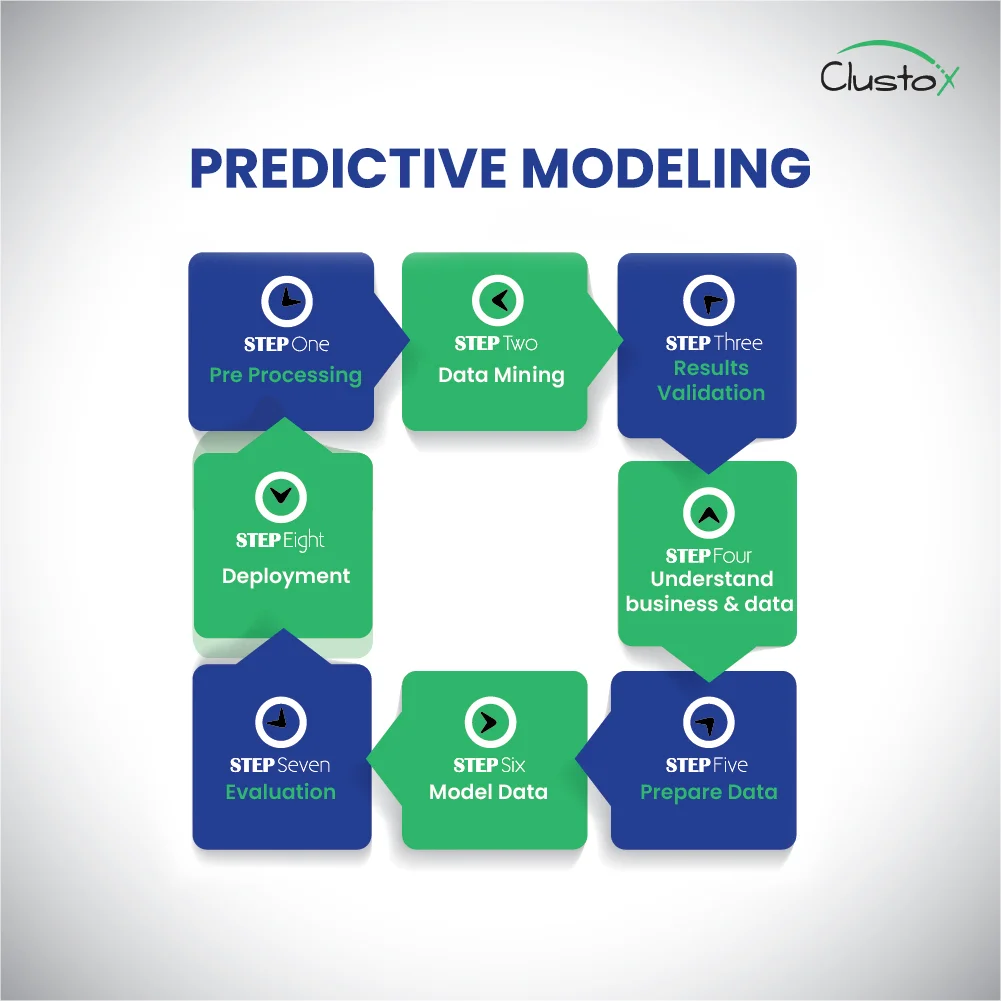
Table of Contents
By utilizing predictive modeling, organizations can improve decision-making processes, increase resource allocation, and gain a competitive edge in various industries, including finance, healthcare, retail, and manufacturing.
Key Business Applications of Predictive Modeling
Predictive modeling is far more than just industry jargon. It’s a tool shaping how businesses operate, making data driven decisions with predictive modeling, and unlocking new opportunities.
As businesses navigate increasingly competitive and dynamic markets, predictive modeling has become an essential tool for strategic growth and risk management.
Across various sectors, companies are using predictive modeling to drive efficiency, increase customer experiences, and mitigate risks.
With advancements in AI & machine learning solutions, predictive modeling allows organizations to forecast outcomes, improve operations, and increase decision-making.
Here’s a look at some of its most powerful applications:
1. Data-Driven Decision-Making
Predictive modeling in business decision-making is based on patterns and trends within their data. Rather than relying on guesswork or intuition, companies can:
- Forecast sales and revenue with greater accuracy.
- Improve pricing strategies based on demand fluctuations.
- Determine the impact of market trends before they fully materialize.
2. Deeper Customer Insights and Personalization
Understanding customer behavior is essential for growth, and predictive modeling helps businesses:
- Identify customer preferences by analyzing historical purchasing patterns.
- Predict customer churn, allowing companies to take proactive retention measures.
- Implement personalized marketing strategies by anticipating customer needs and preferences.
3. Increased Operational Efficiency
Organizations can increase productivity and reduce waste by using predictive modeling to:
- Improve supply chain management by forecasting demand and avoiding overstocking or stockouts.
- Predict machine failures in manufacturing, reducing downtime and maintenance costs.
- Improve workforce planning by analyzing labor needs and adjusting staffing accordingly.
4. Effective Risk Management and Fraud Prevention
Predictive modeling helps businesses safeguard against risks and fraud by:
- Detecting fraudulent transactions in real-time using anomaly detection techniques
- Assessing credit risk before approving loans or extending credit to customers.
- Forecasting potential financial downturns and enabling proactive mitigation strategies.
5. Gaining a Competitive Advantage
Companies that effectively implement predictive modeling have a competitive edge over others by:
- Identifying market shifts before competitors and adapting strategies accordingly.
- Enhancing product development by predicting future consumer demands.
- Using predictive insights to improve customer service and ensure better user experiences.
Is your business facing unpredictable market trends, inefficient operations, or missed opportunities?
Start making data-driven decisions today with an advanced algorithm!
Benefits of Implementing Predictive Modeling
With continuous tech advancements, organizations that are capable of integrating predictive modeling in 2025 into their workflow can have a significant competitive advantage.
By using historical big data and advanced architectures, businesses can make more accurate forecasts, improve operations, and drive strategic decision-making.
Here are the key benefits of predictive modeling for businesses:
1. Increased Revenue & Business Growth
Predictive modeling enhances decision-making and customer targeting, leading to:
- More effective marketing campaigns that improve conversion rates.
- Better pricing strategies based on demand forecasting and customer behavior analysis.
- Identification of high-value customers, enabling personalized engagement that boosts sales.
2. Better Customer Experience and Retention
By understanding customer preferences and behaviors, businesses can:
- Anticipate customer needs and offer tailored products and services.
- Improve customer satisfaction through proactive support and engagement.
- Reduce churn by identifying at-risk customers and implementing targeted retention strategies.
3. Cost Reduction and Operational Efficiency
Predictive modeling helps organizations streamline operations and reduce costs by:F
- Optimizing inventory management to prevent overstocking or shortages.
- Reducing maintenance costs through predictive maintenance in manufacturing and logistics.
- Enhancing workforce planning by predicting staffing needs and minimizing inefficiencies.
4. Improved Forecasting Accuracy
Unlike traditional forecasting methods, predictive modeling:
- Analyzes multiple variables simultaneously for more precise predictions.
- Helps businesses adapt quickly to market changes by providing real-time insights.
- Supports financial planning by forecasting revenue trends and potential risks.
5. Strengthening Risk Management and Fraud Detection
Organizations can mitigate risks and safeguard assets by:
- Identifying potential fraud through anomaly detection in financial transactions.
- Assessing credit risk before approving loans or extending credit.
- Predicting potential security breaches and implementing proactive cybersecurity measures.
6. Introducing a Data-Driven Culture
Integrating predictive modeling fosters a mindset where data is at the core of decision-making:
- Encourages teams to rely on data insights rather than intuition.
- Promotes cross-functional collaboration by making data accessible and actionable.
- Increased innovation by uncovering hidden trends and new business opportunities.
Despite the benefits, 74% of companies struggle to scale AI solutions, including predictive analytics, due to challenges such as data privacy concerns, a lack of skilled personnel, and integration complexities.
Emerging Trends in Predictive Modeling for 2025
artificial intelligence, data processing, and automation.
Organizations are using predictive models to gain deeper insights, increase decision-making, and stay competitive in an increasingly data-driven world.
Here are the key trends shaping predictive modeling in 2025:
1. AI-Driven Predictive Modeling
The integration of artificial intelligence (AI) and machine learning (ML) is transforming predictive modeling by:
- Automating feature selection and model tuning to improve accuracy.
- Enhancing real-time adaptability for dynamic environments.
- Reducing human intervention, allowing for self-learning, and evolving models.
2. More Advanced Data Visualization & Explainable Models
As predictive models become more complex, the need for interpretability grows. Organizations are adopting:
- Interactive dashboards that present model outputs in a more digestible format.
- Explainable AI (XAI) techniques to provide transparency in model decision-making.
- Advanced storytelling approaches that help non-technical stakeholders understand predictions.
3. Democratization of Predictive Modeling
With the rise of no-code and low-code platforms, predictive modeling is becoming more accessible to a wider audience:
- Business users can build and deploy models without extensive coding knowledge.
- Citizen data scientists can experiment with predictive modeling using user-friendly interfaces.
- More cross-functional teams can use predictive insights without reliance on specialized data science teams.
4. Ethical AI & Responsible Data Governance
As predictive models impact more areas of business and society, ethical considerations are taking center stage:
- Increased regulations to ensure bias-free and fair predictive models.
- Stricter data privacy policies and transparent model auditing.
- Greater accountability in AI-driven predictions to prevent unintended consequences.
5. Real-Time Predictive Modeling for Instant Decision-Making
Organizations are moving toward real-time predictive modeling to gain a competitive edge by:
- Analyzing live data streams to predict customer behavior on the fly.
- Enhancing supply chain efficiency with real-time demand forecasting.
- Enabling fraud detection systems that instantly flag suspicious transactions.
How Predictive Modeling is Shaping Business Decisions?
The big data analytics market was approximately USD 348.21 billion in 2024 and is projected to grow to around USD 924.39 billion by 2032.
Predictive modeling is not just improving business processes to deal with big data; it’s shaping decision-making across all levels of an organization. Let’s explore how it drives smarter and more strategic choices:
1. Data-Driven Precision in Decision-Making
The era of depending solely on intuition or outdated reports is over, and predictive modeling now plays a crucial role in data-driven strategies. Predictive modeling enables decision-makers with real-time insights derived from complex data analysis.
By utilizing advanced algorithms and statistical models, organizations can predict outcomes with remarkable accuracy, reducing uncertainty and enhancing strategic planning. This transition from reactive to proactive decision-making provides a competitive edge in an increasingly data-driven world.
2. Proactive Problem-Solving and Risk Mitigation
Predictive modeling enables businesses to identify and address potential challenges before they escalate. Predecting supply chain disruptions, detecting fraud, or forcasting customer churn, these models allow organizations to implement proactive strategies.
For instance, an online retailer can analyze user engagement patterns to detect signs of decreasing customer interest and deploy targeted campaigns to re-engage them, preventing revenue loss and strengthening customer loyalty.
3. Enhancing Customer Retention and Loyalty
In this advanced tech world, retaining customers is paramount. Predictive models analyze behavioral patterns to identify at-risk customers, enabling companies to implement personalized retention strategies.
From promotions to proactive customer service outreach, predictive analytics enhances customer experience and fosters brand loyalty. By predicting and addressing customer needs in advance, businesses create lasting relationships that drive sustained success.
4. Agility in a Dynamic Market
Speed and adaptability are crucial in a rapidly evolving business environment. Predictive modeling facilitates quick, informed responses to market shifts, consumer preferences, and emerging trends.
Companies equipped with real-time forecasts can pivot strategies swiftly, improve inventory, and capitalize on new opportunities as they arise. For instance, a retailer can dynamically adjust pricing and stock levels based on predictive demand models, ensuring optimal profitability and customer satisfaction.
Predictive Modeling in Action
Let’s find out how various industries are using predictive modeling to forecast trends, improve operations, and drive smarter decisions.
| Industry | Predictive Modeling Example | Benefit |
|---|---|---|
| Retail | Demand forecasting for inventory management | Reduces stock shortages and overstocking |
| Finance | Credit scoring to assess loan eligibility | Minimizes risk and prevents fraud |
| Healthcare | Disease prediction using patient data | Enables early intervention and personalized care |
| Marketing | Customer churn prediction | Helps retain customers with targeted strategies |
| E-commerce | Product recommendation engines | Enhances customer experience and sales |
| Manufacturing | Predictive maintenance for machinery | Reduces downtime and repair costs |
| Insurance | Fraud detection in claims processing | Prevents financial losses due to fraudulent claims |
| Supply Chain | Delivery time estimation based on traffic and weather data | Improves logistics efficiency and customer satisfaction |
| Energy | Power consumption forecasting | Optimizes energy distribution and reduces waste |
| Human Resources | Employee attrition prediction | Helps implement retention strategies |
Conclusion
Predictive modeling shapes the future by improving decision-making and efficiency through steps like data collection, model training, and evaluation. It applies to areas like customer experience, supply chain, and marketing.
By using predictive modeling in 2025, businesses can achieve growth, manage risks, and make smarter decisions. To fully benefit, companies must focus on data quality, invest in the right tools, and foster a data-driven culture.
With advanced predictive models, we are providing businesses with solutions to ensure their digital transformation, enabling them to unlock new growth opportunities, mitigate risks, and make informed decisions in an increasingly complex tech world.
Worried About Missed Opportunities, Slow Growth, Rising Costs, and Inefficient Strategies?
Don’t let guesswork slow you down!
Frequently Asked Questions (FAQs)
How Is Predictive Modeling Shaping Data-Driven Decision-Making?
It enables businesses to make proactive, data-backed decisions by predicting trends, risks, and opportunities with greater accuracy.
What Are the Latest Trends in Predictive Modeling in 2025?
Key trends include AI-driven automation, real-time analytics, ethical AI, and the integration of quantum computing for faster predictions.
Why is Predictive Modeling Important for Businesses in 2025?
It enhances efficiency, reduces risks, improves customer experiences, and drives innovation through smarter, data-driven strategies.

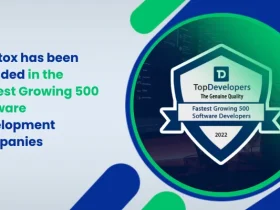


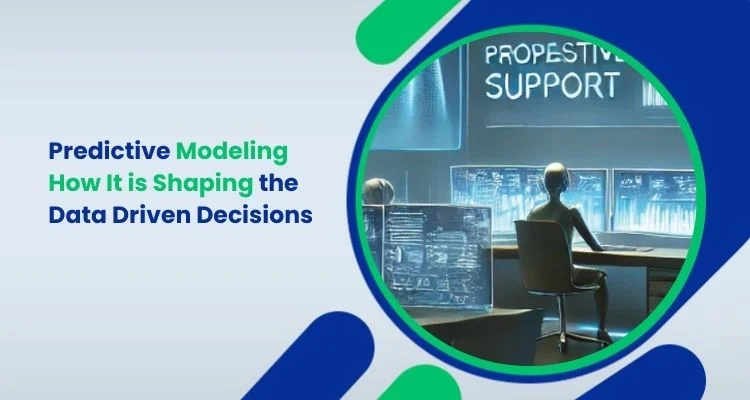
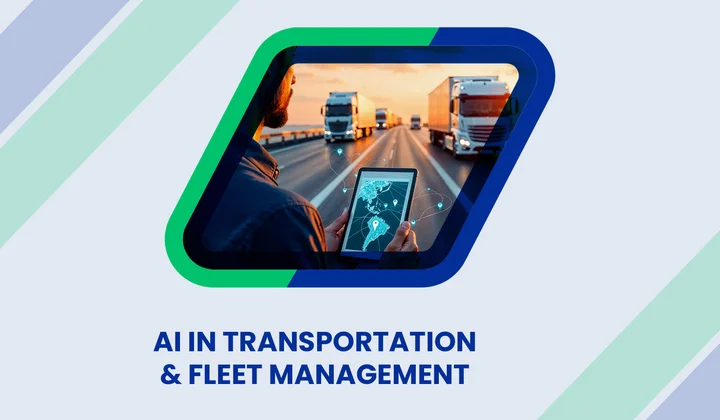
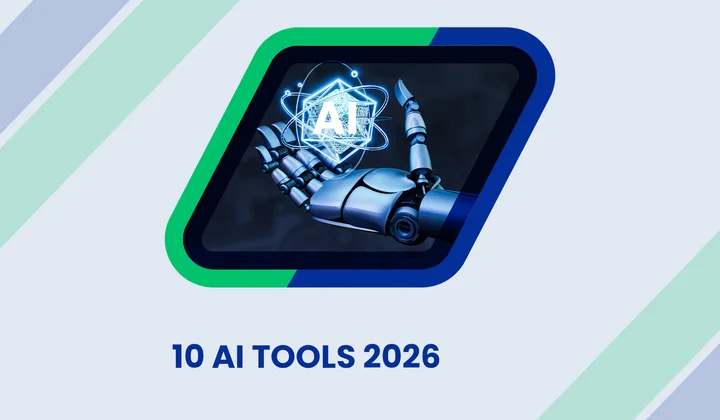
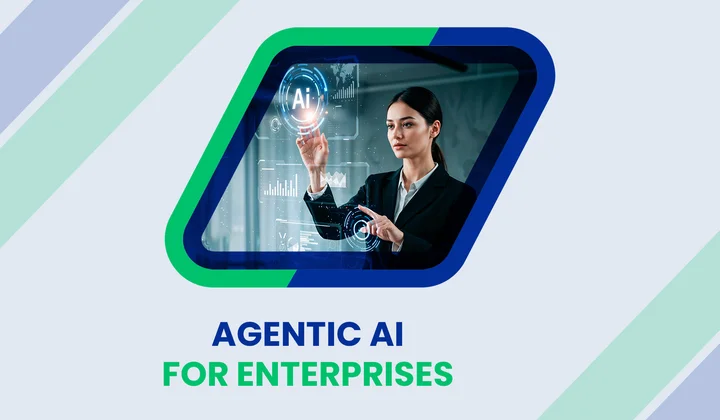
Share your thoughts about this blog!